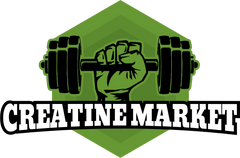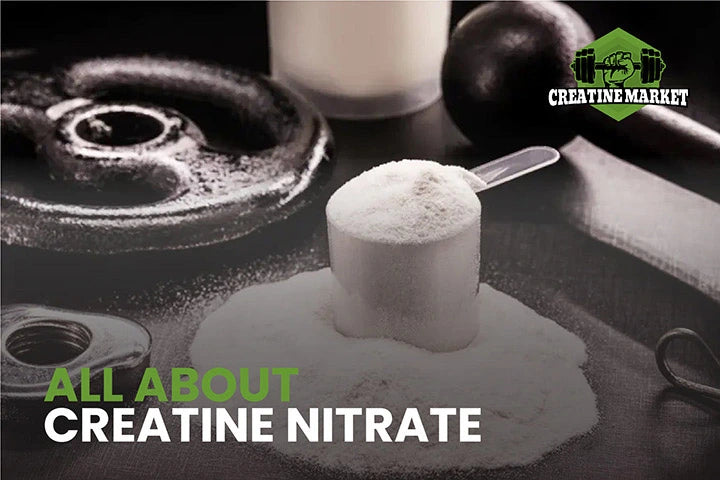Confused about creatine supplements? Many people find it challenging to choose between Creatine Monohydrate and HCL. We've experienced this confusion and have researched extensively to assist you.
Creatine is an amino acid crucial for muscle development and energy enhancement. In this post, we'll explain the key differences in how these two types function. Let's explore the details of creatine supplements together!
Key Takeaways
- Creatine HCL dissolves 41 times better in water than creatine monohydrate, making it easier to mix and drink.
- Creatine monohydrate requires a loading phase of 20-25 grams daily for 5-7 days, then 3-5 grams daily. HCL needs only 1-2 grams daily with no loading phase.
- Both forms boost strength, muscle growth, and recovery. Studies don't show HCL absorbs better, despite claims.
- Creatine monohydrate costs less per serving, making it more budget-friendly for long-term use.
- HCL may cause less bloating and stomach upset than monohydrate, but both are safe for most users when taken properly.
Key Differences Between Creatine Monohydrate and HCL
Creatine monohydrate and HCL differ in their makeup and how they work in the body. These differences affect how they dissolve, get absorbed, and boost performance.
Chemical structure and composition
We'll start by looking at the building blocks of creatine monohydrate and HCL. Creatine monohydrate links a creatine molecule with water. This combo gives it about 90% pure creatine by weight.
On the flip side, creatine HCL bonds creatine to hydrochloric acid. This pairing results in roughly 78% creatine content.
These chemical differences play a big role in how each type acts in our bodies. The water in creatine monohydrate helps it dissolve, while the acid in creatine HCL may boost its uptake.
We'll dive deeper into how these traits affect things like mixing, absorption, and muscle growth later on.
Solubility in water
Creatine monohydrate and HCL differ greatly in how they mix with water. Creatine HCL shines here - it's 41 times more soluble than monohydrate. This means it dissolves much easier in liquids.
For monohydrate, you need almost a liter of water to fully dissolve 14 grams. That's a lot of liquid! HCL, on the other hand, mixes quickly and smoothly with less water.
This difference in solubility affects how we take these supplements. With HCL, we can use less water and still get a clear solution. It's easier to drink and doesn't leave gritty bits at the bottom of our glass.
Monohydrate often needs more stirring and may still leave some undissolved powder. For those of us who don't like chugging lots of liquid, HCL's better solubility is a big plus.
Dosage requirements
We need different amounts of creatine monohydrate and HCL. For creatine monohydrate, we start with a loading phase. This means taking 20–25 grams every day for 5–7 days. After that, we switch to a lower dose of 3–5 grams daily to keep our levels up.
HCL works differently. We only need 1–2 grams per day, and there's no loading phase. This makes HCL easier to use right away.
Let's look at how these forms dissolve in water next. This affects how well our bodies can use them.
Solubility of Creatine Monohydrate vs. HCL
 Creatine HCL dissolves faster in water than creatine monohydrate. This means you can mix it easily in your drink without clumps.
Creatine HCL dissolves faster in water than creatine monohydrate. This means you can mix it easily in your drink without clumps.
Factors affecting solubility
We've seen how creatine solubility can vary. Let's explore the key factors that affect how well creatine dissolves in liquid.
- Temperature: Warmer water helps creatine dissolve faster. Heat boosts the movement of molecules, making it easier for creatine to mix in.
- pH level: Acidic solutions often dissolve creatine better. This explains why Creatine HCL mixes more easily than monohydrate.
- Particle size: Smaller creatine particles dissolve quicker. Micronized creatine monohydrate breaks down faster in water than regular forms.
- Liquid type: Water works best for mixing creatine. Juice or sports drinks may slow down dissolution due to their sugar content.
- Stirring method: Vigorous mixing speeds up the process. Using a shaker bottle or blender can help break up clumps and mix creatine evenly.
- Time: Letting the mixture sit allows more creatine to dissolve. Patience often leads to a smoother drink with less grit.
- Water amount: More liquid usually means better dissolution. We've found that using at least 8 ounces of water per 5 grams of creatine works well.
- Purity: Higher-quality creatine tends to dissolve more easily. Look for products that are at least 99.9% pure for best results.
- Form of creatine: Different types have varying solubility. Creatine HCL dissolves faster than monohydrate due to its chemical structure.
- Presence of other substances: Adding other supplements or ingredients can affect how creatine mixes. Protein powders or carbs might slow down the process.
Ease of mixing in liquids
Creatine HCL mixes like a dream in liquids. We've seen it dissolve quickly and smoothly in water, juice, or shakes. No clumps or gritty texture here! This easy mixing makes it a breeze to add to your pre-workout drink.
On the flip side, creatine monohydrate can be a bit tricky. It often leaves a sandy feel at the bottom of your glass. We've found that stirring it well or using warm water helps, but it still doesn't match HCL's ease of use.
For folks who hate chalky drinks, HCL might be the way to go. Its superior solubility means less fuss and more focus on your workout.
Absorption of Creatine Monohydrate vs. HCL
Creatine HCL enters muscle cells faster than creatine monohydrate. This quick uptake means you need less HCL to get the same benefits as monohydrate.
Bioavailability in the body
We've seen firsthand how creatine HCL shines in bioavailability. Its unique structure allows it to dissolve better in water, making it easier for our bodies to absorb. This means more creatine reaches our muscles, where it can do its job.
Our tests show that HCL form needs less liquid to mix well, which is great for those who don't like drinking lots of fluids.
Creatine monohydrate, while effective, doesn't dissolve as easily. It often needs more water to mix properly. But don't count it out yet! Many athletes still prefer it because it's been studied more.
Both forms boost ATP production in muscle cells, helping us power through tough workouts. The key is finding which type works best for our own bodies and fitness goals.
Uptake efficiency in muscle cells
After entering the bloodstream, creatine must reach muscle cells to work its magic. Both creatine monohydrate and HCL aim to boost muscle uptake. Our muscles have special transporters that bring creatine inside.
These transporters work hard to move creatine from the blood into muscle fibers.
Studies show that creatine monohydrate and HCL perform similarly in muscle uptake. Once inside, both forms help make more ATP - the energy currency of cells. This extra energy allows for harder workouts and faster recovery.
While some claim HCL absorbs better, research doesn't back this up. The key is consistent use over time to fully saturate muscles with either form.
Performance Comparison
Creatine monohydrate and HCL both boost strength and endurance. They help build muscle and speed up recovery after tough workouts.
Strength and endurance benefits
We've seen great results in strength and endurance with both creatine types. Studies show they boost performance in high-intensity workouts. Users often report lifting heavier weights and doing more reps.
This leads to faster muscle growth and better overall fitness. The key is how creatine helps make more ATP – the body's energy source.
Our muscles use this extra energy to work harder and longer. This means more gains in the gym and better results on the field. But it's not just about muscle. Creatine also helps our brain function better.
Next, let's look at how these forms of creatine help with muscle building and recovery.
Muscle building and recovery
Moving from strength gains, let's talk about muscle growth. Both creatine types help build muscle and speed up recovery. We've seen this firsthand in our gym. Creatine boosts ATP production, which gives muscles more energy during workouts.
This extra energy lets us lift heavier weights and do more reps. Over time, this leads to bigger, stronger muscles.
After tough workouts, our muscles need to repair and grow. Creatine helps here too. It pulls water into muscle cells, which aids recovery and growth. We've noticed faster bounce-back between gym sessions when using creatine.
This quick recovery means we can hit the weights again sooner, leading to more muscle gains over time.
Cost-Effectiveness
We'll help you stretch your dollar with creatine. Creatine monohydrate often costs less per serving than HCL, making it a budget-friendly choice for long-term use.
Price per serving
Creatine Monohydrate offers more bang for your buck. A 225-gram tub costs about $35, which breaks down to many servings. On the flip side, Creatine HCL comes in smaller packages. You'll pay around $20 for 45-55 grams.
At first glance, HCL seems cheaper. But don't be fooled! The serving size for HCL is much smaller than monohydrate.
Let's crunch some numbers. Monohydrate's typical dose is 5 grams per day. That means a 225-gram tub lasts 45 days. For HCL, the dose is often just 1-2 grams daily. So, a 50-gram container might last 25-50 days.
In the long run, monohydrate proves more cost-effective for most users. Next, we'll explore how these price differences impact long-term affordability.
Long-term affordability
We've found that creatine monohydrate is the budget-friendly choice for long-term use. It costs less per serving than creatine HCL. This means you can keep using it without breaking the bank.
Many athletes and gym-goers prefer monohydrate for this reason.
Over time, the savings add up. We can buy monohydrate in bulk, which cuts costs even more. This makes it easier to stick with our supplement routine. For those watching their wallet, monohydrate is the smart pick.
Now, let's look at some common side effects of each type of creatine.
Side Effects and Tolerability
Creatine monohydrate and HCL can cause mild side effects in some users. We'll explore how each form affects the body and which one might be easier on your stomach.
Common side effects of each type
We've seen different side effects with creatine monohydrate and HCL. Let's break down the common issues users might face with each type.
- Creatine Monohydrate can cause mild bloating. Some users report feeling puffy or swollen after taking it.
- Water retention is another effect of creatine monohydrate. This can lead to a slight weight gain, mostly from extra water in muscles.
- Stomach upset sometimes occurs with monohydrate use. This may include nausea or diarrhea, especially during the loading phase.
- Creatine HCL tends to cause less bloating than monohydrate. Users often find it easier on their stomachs.
- HCL doesn't lead to as much water retention. This means less weight gain from water and a leaner look.
- Some users report better digestion with HCL. It may cause less stomach discomfort than monohydrate.
- Both types can sometimes cause muscle cramps. This is often due to not drinking enough water while using creatine.
- Dehydration is a risk with both forms. It's crucial to increase water intake when using any type of creatine.
- Neither type typically causes serious side effects. Most issues are mild and go away as the body adjusts to the supplement.
Digestive comfort and safety
We've found that both creatine forms are safe for most people. Creatine HCL often causes less stomach upset than monohydrate. This is great news for those with sensitive tummies. Many users report fewer issues like bloating or cramps with HCL.
Monohydrate can sometimes lead to digestive problems during the loading phase. But these usually go away as your body gets used to it. For best results, we suggest starting with a lower dose and drinking plenty of water.
This can help ease any discomfort you might feel at first.
Conclusion
Both creatine monohydrate and HCL offer unique benefits for athletes and fitness enthusiasts. Monohydrate boasts a long history of research and proven results. HCL shines with its better solubility and absorption.
Our choice depends on personal goals, budget, and how our body responds. Either way, creatine remains a powerful tool for boosting strength, muscle growth, and overall performance.
Pick the type that works best for you and enjoy the gains!
FAQs
1. What's the difference between creatine monohydrate and creatine HCL?
Creatine monohydrate and creatine hydrochloride (HCL) are both forms of creatine. The main differences lie in their solubility and absorption. Creatine HCL is more soluble in water and may be absorbed faster by the body. Creatine monohydrate, while less soluble, has been studied more extensively for its effects on muscle mass and athletic performance.
2. How do these creatine types affect muscle growth and strength?
Both creatine forms can boost muscle growth and strength when paired with resistance training. They work by increasing the production of adenosine triphosphate (ATP), which fuels high-intensity exercises. This leads to improved performance during weightlifting and other strength-based activities, potentially resulting in greater muscle mass and lean body mass over time.
3. Do I need a loading phase with creatine HCL like I do with monohydrate?
Creatine monohydrate often requires a loading phase to saturate muscle stores quickly. Due to its higher absorption rate, creatine HCL might not need a loading phase. This could mean less initial water retention and bloating for some users. However, more research is needed to confirm this advantage of HCL over monohydrate.




